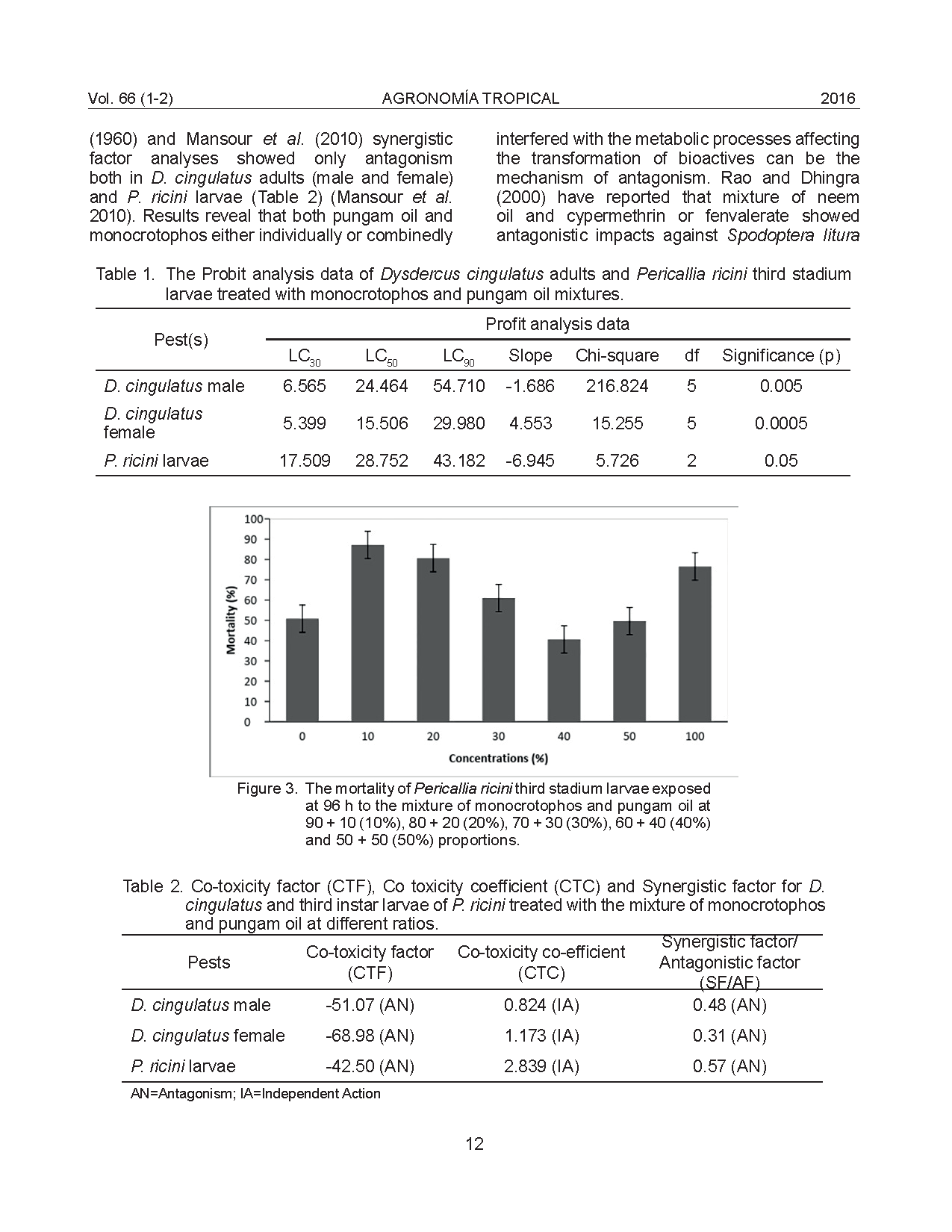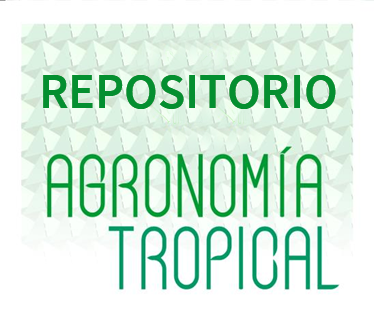Actividad insecticida de las combinaciones de monocrotofos y pungam para el manejo de plagas de algodón en condiciones de laboratorio
Resumen
Se evaluó en condiciones de laboratorio los efectos conjuntos de aceite de pungam crudo y el insecticida convencional monocrotofós, sobre larvas de tercer estadio de Pericallia recini (Fab.) (Lepidoptera: Arctiidae) y adultos del chinche rojo del algodón Dysdercus cingulatus (Fab.) (Hemiptera: Pyrrhocoridae). Monocrotofos y aceite de pungam se mezclaron en las proporciones 9:1, 8:2, 7:3, 6:4 y 5:5 y se utilizaron para los bioensayos. La mortalidad dependiente de la dosis no se observó en los insectos ensayados. Dysdercus cingulatus machos mostraron mayor resistencia que las hembras. Entre las dos plagas evaluadas, las larvas del lepidóptero mostraron más resistencia que los adultos del hemíptero. Los efectos sinérgicos de monocrotofos con aceite de pungam se calcularon por medio de coeficientes de Sun Co-toxicidad (CTC) y Coeficiente sinérgica de Finney (SC), Se registraron acciones independientes y antagonistas, respectivamente. En conclusión, se encontró que el plaguicida actuaba aditivamente con aceite de pungam bajo condiciones ensayadas in vitro.
Descargas
Citas
• Abo-El Seoud, MA; Sarhan, MM; Omar, AE; Helal, MM. 2005. Biocides formulation of essential oils having antimicrobial activity. Arch. Phytopathol. Plant Protection 38(3):175-184.
• Adiroubane, D; Raghuraman K. 2008. Plant products and microbial formulation in the management of brinjal shoot and fruit borer, Leucinodes orbonalis Guenee. Journal Biopesticides 1(2):124-129.
• Chockalingam, S; Mala, S; Nalinasundari, MS.1987. Antifeedent activity of neem oil extractive on the pest Pericalliaricini F. (Lepidoptera: Arctiidae). Proceeding of Symposium on Alternatives to synthetic insecticides, CRME, Madurai, 83-89 p.
• Finney, DJ. 1971. Probit Analysis, 3rd ed. Cambridge University Press, Cambridge.132 p.
• Franzios, G; Mirotsou, M; Hatziapostolou, E; Kral, J; Scouras, ZG; Mavragani-Tsipidou; P. 1997. Insecticidal and genotoxic activities of mint essential oils. Journal of Agricultural and Food Chemistry 45(7):2690-2694.
• Khalequzzaman, M; Nahar, J. 2001. Toxicity of nine insecticides to adult Tribolium castaneum (Herbst). OnLine Journal of Biological Sciences 1(11): 1043-1045.
• Koppenhofer, AM; Fuzy, EM. 2003. Biological and chemical control of the Asiatic garden beetle Maladeracastanea (Coleoptera: Scarabaeidae). Journal of Economic Entomology 96:1076-1082.
• Kumar, M; Singh, R. 2002. Potential of Pongania glabra Vent as an insecticide of plant origin. Biological Agriculture and Horticulture 20:29-50.
• Kumar, SMB; Kalidhar; SB. 2003. A review of the chemistry and biological activity of Pongamia pinnata. Journal of Medicinal and Aromatic Plants 25:441-465.
• Kwon, DH; Clark, JM; Lee, SH. 2010. Extensive gene duplication of acetylcholinesterase associated with organophosphate resistance in the two-spotted spider mite. Insect Biochemistry and Molecular Biology 19:195-204.
• Mansour, SA; Bakr, RFA; Hamouda, LSA; Mohamed, RI. 2010. Toxic and synergistic properties of several botanical extracts against larval and adult stages of the mosquito, Anopheles pharoensis. Biopesticide International 6(2):129-145.
• Manzoor, U; Haseeb, M. 2015. Laboratory evaluation of different botanicals against the red cotton bug, Dysdercus cingulatus (Fabricius) and cotton mealybug, Phenacoccus solenopsis(Tinsley) in okra. International Journal Of Research In Medical Sciences 2(2):28- 32.
• Mariam, MA; Chandramohan, N. 2000. Evaluation of chemical insecticides and botanicals against various stages of spiralling whitefly, (Aleurodicus dispersus Russell) on mulberry. The Madras Agriculture Journal 87(7/9):379-381.
• Martín-López, B; Varela, I; Marnotes, S; Cabaleiro, C. 2006. Use of oils combined with low doses of insecticide for the control of Myzus persicae and PVY epidemics. Pest Management Science 62:372–378.
• Mathur, A; Singh, S; Singh, NP; Meena; M. 2012. Field evaluation of plant products and microbial formulations against brinjal shoot and fruit borer, Leucinodes orbonalis Guenee under semi-arid conditions of Rajasthan. Journal Biopesticides 5(1):71-74.
• Morales-Rodriguez, A; Peck, DC. 2009. Synergies between biological and neonecotinoid insecticides for the curative control of white grubs Amphimallon majale and Popillia japonica. Biological Control 51:169-180.
• Narasimhan, V; Rajappan, K; Ushamalini, C; Abdul Kareem, A. 1998. Efficacy of new EC formulations of neem oil and pungam oil for the management of sheath rot disease of rice. Phytoparasitol 26:301-306.
• NBAIR (National Bureau of Agricultural Insect Resources). 2018. Available: https://bit.ly/2vK3K2o
• Packiam, SM; Ignacimuthu, S. 2012. Effect of PONNEEM# on Spodoptera litura (Fab.) and its compatibility with Trichogramma chilonis Ishii. Brazilian Archives of Biology and Technology 55(2):291-298.
• Packiam, SM; Baskar, K; Ignacimuthu, S. 2014. Feeding deterrent and growth inhibitory activities of PONNEEM, a newly developed phytopesticidal formulation against Helicoverpa armigera (Hubner). Asian Pacific Journal of Tropical Biomedicine 4:S323-S328.
• Pandey, RS; Prasad, R; Srivastava, JP; Tiwari, R; Mathur, YK. 1980. Relative toxicity of insecticides to the larvae of Percicalliaricini Fabr. Indian Journal of Entomology 42(2): 276-278.
• Radhika, SA; Sahayaraj K. 2014. Synergistic effects of monocrotophos with botanical oils and commercial neem formulation on Spodoptera litura (Fab.) (Lepidoptera: Noctuidae). Journal Biopesticides 7 (Suppl.):152-159.
• Rajappan, K; Malini, CU; Narasimhan, V; Kareem, AA. 1999. Effect of solvent-free EC formulations of neem and pungam oils on the survival of Nephotettix virescens and rice yellow dwarf transmission. Annals of Plant protection Sciences 7(2):220-222.
• Rajappan, K., C. Ushamalini, N. Subramanian, V. Narasimhan and A.A. Kareem 2001. Management of grain discoloration of rice with solvent-free EC formulations of neem and pungam oils. Phytoparasitca 29(2):171-174.
• Ramaraju, K. 2004. Evaluation of acaricides and TNAU neem oils against spider mite, Tetranychusurticae (Koch) on bhendi and brinjal. The Madras Agriculture Journal 91:425-429.
• Rao, GR; Dhingra, S. 1997. Synergistic activity of some vegetable oils in mixed formulations with cypermethrin against different instars of Spodoptera litura Fab. Journal of the Entomological Research Society 21:153- 160.
• Rao, GR; Dhingra, S. 2000. Variations in the efficacy of mixed formulations comprising vegetable oils and synthetic pyrethroids against susceptible (Delhi) and resistant (Guntur) larval populations of Spodoptera litura (Fab.). Journal of the Entomological Research Society 24(2):115- 120.
• Pavela, R; Herda, G.2007. Repellent effects of pongam oil on settlement and oviposition of the common greenhouse whitefly Trialeurodes vaporariorum on chrysanthemum. Chinese Academicals Sciences 14:219-224.
• Srinivasa Rao, N; Rajendran, R; Raguraman, S. 2003. Laboratory assessment of the potentiation of neem extract with the extracts of sweet-flag and pungam on bhendi shoot and fruit borer, Earias vitella (Fab.). Entomon, 28:277-281.
• Srivastava, B; Sagar, A; Dubey, NK; Sharma, L. 2015. Essential oils for pest control in agroecology. In: Sustainable Agriculture Reviews, Springer International Publishing, 329-352 p.
• Sun, YP; Johnson,E. 1960. Analysis of joint action of insecticides against house flies. Journal of Economic Entomology 53(5):887-892.
• Thangam, TS; Kathiresan, K. 1990. Synergistic effects of insecticides with plant extracts on mosquito larvae. Tropical Biomedicine 7(2):135-137.
• Vastrad, AS; Lingappa, S; Basavanagoud, K. 2002. Vegetable oils as synergists of synthetic pyrethroids against diamondback moth, Plutella xylostella L. (Yponomeutidae: Lepidoptera). Journal of the Entomological Research Society 26:285-290.
• Vennila, S; Ramasundram, P; Sheo Raj; Kairon, MS. 2013. Cotton IPM and its current status Central Institute for Cotton Research Nagpur. CICR Technical Bulletin 8: 13 p.
• War, AR; Paulraj, MG; Ignacimuthu, S. 2011. Synergistic activity of endosulfan with neem oil formulation against tobacco caterpillar Spodoptera litura (Fab.) (Lepidoptera: Noctuidae). Journal of Entomology (6):530-538.
• WHO (World Health Organization). 2009. Health implications from monocrotophos use: a review of the evidence in India. Regional Office for South East Asia- 60 p





